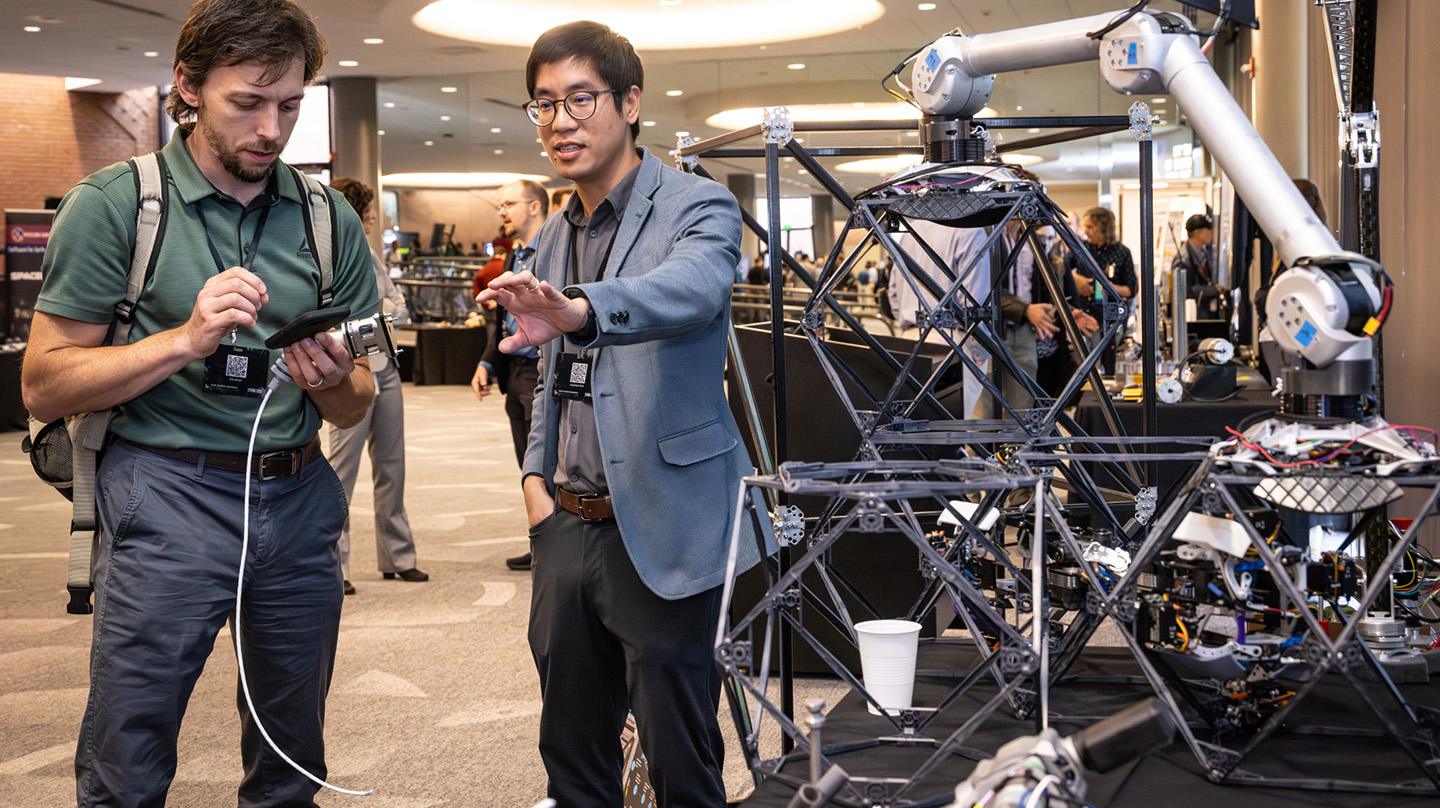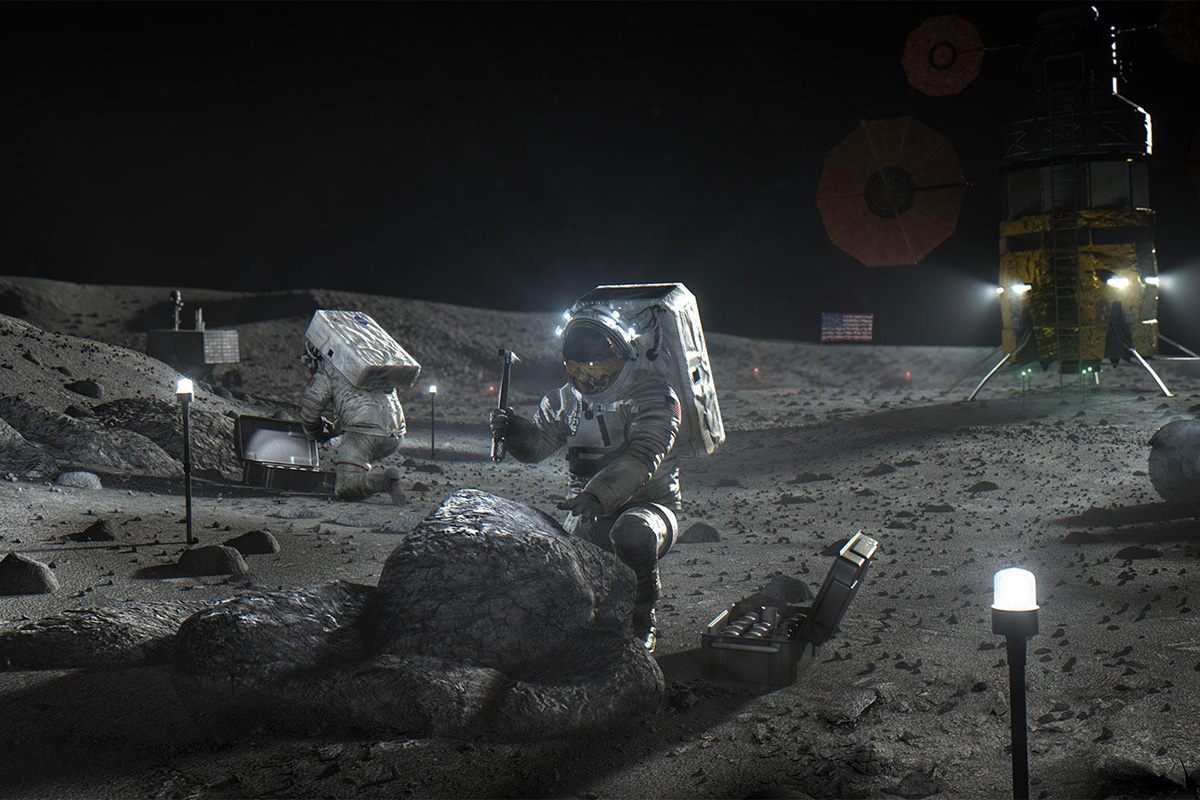Press Release
Lunar Innovation Consortium Powering a Path Back to the Moon
Audio generated using AI voice technology.
What began in 2020 as a one-day meeting on the campus of the Johns Hopkins Applied Physics Laboratory (APL) in Laurel, Maryland, has bloomed into a national engine of innovation — and an important part of America’s return to the Moon.
Five years after that inaugural gathering, the Lunar Surface Innovation Consortium (LSIC) — led by APL on behalf of NASA’s Space Technology Mission Directorate (STMD) — has grown from a bold idea into a thriving community of more than 3,500 members from 1,200 organizations across all 50 states and internationally.
Formed under NASA’s Lunar Surface Innovation Initiative (LSII), LSIC was created to unite the landscape of small businesses, technology developers, start-ups and other U.S. organizations toward advancing the foundational technologies required to fulfill missions on the Moon’s surface and establish a long-term presence there in preparation for venturing to Mars.
“We’ve seen LSIC member technologies grow by leaps and bounds, to where some have landed on the Moon and collected data,” said Wes Fuhrman, LSII lead at APL. “It’s been an amazing progression made possible by dedicated effort, creative solutions and collaboration.”
LSIC not only elevates voices across a broad range of industries, Fuhrman added, but supports open communication and collaboration among members, which accelerates critical technologies toward delivering a sustained presence on the Moon.
To the Moon — Together
This year’s LSIC Spring Meeting, held May 20-22 on the APL campus, featured prominent voices from industry, government, research institutions and other organizations collaborating on lunar technology advancement.
“At NASA, we advance America’s space technology portfolio by fostering innovation, cultivating breakthrough ideas and embracing risk to fuel a competitive space economy,” said Clayton Turner, associate administrator for NASA’s Space Technology Mission Directorate. “We inspire and collaborate with our communities, like LSIC, to improve life on Earth and beyond.”
During his keynote on the first day of the Spring Meeting, John Couluris, senior vice president of lunar permanence at Blue Origin, compared the quest to establish a long-term lunar presence to the rise of the airline industry in the 20th century, which started with a single route from Key West, Florida, to Havana, Cuba, before morphing into a prosperous multibillion-dollar industry.
“When we talk about building the road to space and millions of people living and working in space, it sounds very grand, but it all starts with one person,” said Couluris, citing the first astronauts to reach the Moon.
More than 600 participants gathered in person and virtually for multiple panels, including discussions of lunar mission technologies, such as those flown on Firefly’s Blue Ghost Mission 1 and Astrobotic’s Griffin Lander on Peregrine Mission One.
Throughout the three-day event, LSIC members demonstrated multiple successes on the Moon and showcased a broad set of technologies ready for flight, underscoring readiness for near-term missions aimed at establishing a lunar infrastructure. Participants also shared lessons learned to help other technology developers prepare for future flights.
Breakout sessions focused on strategies to mature key technologies, such as resource extraction, the repair and reuse of materials and technologies on the lunar surface, and next-generation power systems. The meeting also offered a technology show-and-tell, during which participants displayed models and simulations, and discussed their newest tools and techniques.
“Networking is a core component of every LSIC meeting — building partnerships to transform ideas into reality,” said LSIC Director Jamie Porter at APL. “Participants in the spring gathering engaged with others across the U.S. cislunar ecosystem, highlighting the latest innovations in lunar exploration.”
Starting With One Small Step
Athonu Chatterjee, a scientist at APL and LSIC capability area lead when the consortium started, compared LSIC’s beginnings to a high-tech “garage start-up.”
“It was a handful of people jumping into the ocean without knowing whether we would be able to swim,” Chatterjee said. “But the community lifted LSIC up.”
APL planetary scientist Rachel Klima served as LSIC’s first director, developing its initial charter and guiding principles. From the earliest meetings, Klima remembers not just the enthusiasm but the community’s willingness to embrace cooperation over competition.
“LSIC members may compete in one arena but collaborate in another. It’s been refreshing to see that, as well as how everybody cheers for each other when they do something difficult,” Klima said.
“When you get everybody who is interested in a particular mission and united in a common goal in one room and talking together, things happen so quickly — far faster than can be done with teleconferences or data sheets,” said AJ Gemer, chief technology officer and co-founder of Colorado-based space company Lunar Outpost.
The Next Five Years
The journey by the LSIC community to hone technologies for the Moon is only beginning. The next five years will bring even more opportunities to land LSII/LSIC-driven technologies on the Moon’s surface.
During her Spring Meeting address, Niki Werkheiser, director of technology maturation in STMD, outlined the technology pipeline the agency has established to help U.S. industry successfully develop lunar surface infrastructure.
“Establishing that infrastructure is the essential step we need to go from shorter-term missions like Apollo to longer-term missions on the Moon and Mars,” Werkheiser said. “We have to evolve the footprints to foundations.”
As NASA and commercial partners gear up for more ambitious missions to test hardware and systems on the lunar surface in preparation for a sustained stay, LSIC leaders say the group’s role as a unifying force will continue to grow.
“The community will not only execute technology demonstrations on the Moon,” Fuhrman said, “but show that by working together, we can get there faster and more efficiently.”

